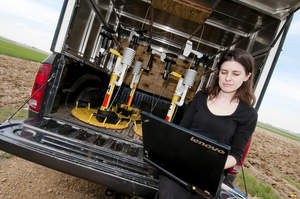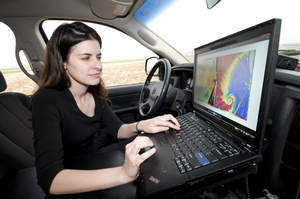Contact Information: Jacquelyn Messer Text 100 Public Relations for Lenovo Ph: 212.871.3952 Mobile: 201.704.7809 jacquelyn.messer@text100.com
Into the Storm: Lenovo PCs Power VORTEX2 Tornado Research Project
Ultimate Business Tool Undergoes Ultimate Tornadic Research Field Test
| Source: Lenovo
RESEARCH TRIANGLE PARK, NC--(Marketwire - May 7, 2009) - Lenovo today announced a
partnership with the non-profit Center for
Severe Weather Research (CSWR) to power advanced levels in tornado and
severe weather research. CSWR is bringing more than 50 Think-branded PCs
into the eye of the storm as part of the $11.9 million VORTEX2 project -- the largest and
most ambitious tornado field research project of its kind. As the lead
agency for the project, the CSWR team will use the Lenovo PCs to help track
and store radar data, guide vehicles in the storm, provide weather
briefings and analyze information for years to come. VORTEX2 begins May 8
in Norman, Oklahoma.
Research meteorologist Dr. Joshua Wurman, president of CSWR, coordinates
radars and tornado pods from the Doppler on Wheels mobile radar, which he
invented to advance the way tornadoes are researched. "This is without a
doubt the largest tornado research project ever undertaken with the sheer
number of participants, the breadth of organizations involved and the
amount of equipment used. To pull off a project of this scale, we need
rugged and reliable PC technology to collect, house and analyze every bit
of data. A fleet of Lenovo PCs will help us see further inside the storm
and help bring some predictability to this natural phenomenon."
VORTEX2 Tornado Research
Based in Boulder, Colo., the CSWR conducts ongoing research on tornadoes,
hurricanes and severe weather. With VORTEX2, the team will work in the
field in "tornado alley" for several weeks to study why some thunderstorms
produce tornadoes while others do not. The efforts will help them better
predict future tornadoes' intensity, duration and path.
VORTEX2 includes a diversity of governmental, academic, non-profit and
international organizations including the National Science Foundation and the National Oceanic and Atmospheric
Association. More than 100 scientists will participate in the field
study, which will span 500,000 square miles across parts of seven states.
They will use more than 40 specially designed vehicles and 70 pieces of
weather equipment to get close to the eye of a storm.
Tracking Down Tornados with Technology
Lenovo PCs are at the heart of information operations for these storm
chasers. Throughout the field study, Lenovo ThinkPad laptops, ThinkCentre
desktops, ThinkVision monitors and IdeaPad netbooks
will crunch millions of megabytes of data in the field. The crew will use a
variety of Lenovo PCs including:
ThinkPad T400 laptops -- Used in the instrumented Probe and Disdrometer
vehicles, these laptops play an important role in transferring data
collected through the dozen weather pods that are placed in the path of a
storm. These pods measure weather data, such as wind speed and temperature.
The laptops also power diagnostic software used to test and monitor weather
stations in the field.
ThinkPad W500 laptops -- Attached to the mounts inside the Probe and
Disdrometer vehicles, these laptops run navigation, tracking and mapping
software.
ThinkPad W700 laptops -- These laptops are used for housing a variety of
radar and mapping applications for analyzing and displaying graphically
demanding data and video without being tied to a desk. The laptops are also
being used for public presentations of preliminary science results as well
as in the field for a first analysis of data.
ThinkPad X200s laptops -- For lightweight and portability, the team is
using these laptops to conduct tornado damage assessments.
ThinkCentre M58p desktops -- The newest Doppler on Wheels, DOW7, is a
mobile radar and serves as a mission control. Inside the heart of the
operations, a library stack of eight Lenovo desktops help crunch
information from the Internet, navigate, translate and display radar data,
and track the CSWR fleet to keep them safe but close to a hazardous
environment. Each PC performs a different function focused on helping run
the mobile radar and weather observatory and radar operations.
ThinkVision L2440x wide and L220x wide monitors -- Housed in the DOW6, the
high resolution monitors step up energy efficiency and video performance
standards for the crew, helping them view the latest, up-to-date
information. The monitors also are being used for weather briefings for the
team of 100 scientists.
IdeaPad S10 netbooks -- Individual scientists are using the netbooks as a
quick and convenient way to check Internet weather forecasts and email.
Click here
to see photos of the Lenovo PCs being used in the CSWR vehicles.
"Lenovo Think-branded PCs have been put through military tests for
reliability and durability, being used by customers with the highest
requirements working in conditions like space or at the far reaches of the
Earth in hot terrain or in freezing temperatures," said Sam Dusi, vice
president, Worldwide ThinkPad Product Marketing. "Going into the eye of the
storm marks a first for our PCs, and we will be working with the Center for
Severe Weather Research team to continually raise the bar on performance on
our ultimate business tools."
Follow Along for the Ride
Click here to
see a video tour of some of the rigs and the technology being used.
Additionally, members of the VORTEX2 project are updating their progress
from the road live through Facebook and Twitter.
About Lenovo
Lenovo (HKSE : 992 ) (ADR: LNVGY) is dedicated to building exceptionally
engineered personal computers. Lenovo's business model is built on
innovation, operational efficiency and customer satisfaction as well as a
focus on investment in emerging markets. Formed by Lenovo Group's
acquisition of the former IBM Personal Computing Division, the company
develops, manufactures and markets reliable, high-quality, secure and
easy-to-use technology products and services worldwide. Lenovo has major
research centers in Yamato, Japan; Beijing, Shanghai and Shenzhen, China;
and Raleigh, North Carolina. For more information see www.lenovo.com.
Links
-- Check out photos and video footage of lead scientist Josh Wurman and his
team on the Lenovo
YouTube Channel and Flickr page.
-- Get the latest storm chasing updates on Twitter by following @vortex2nssl and @LenovoSocial.
-- Join the Facebook group VORTEX2 for
the latest photos and commentary.
-- Read first-hand accounts from Lenovo employees on the Lenovo Blogs as they travel through
"tornado alley" with Josh and his team.
-- Subscribe to Lenovo's
RSS Feed.



